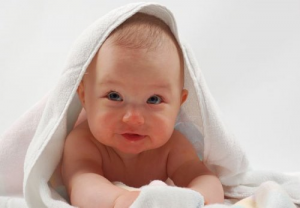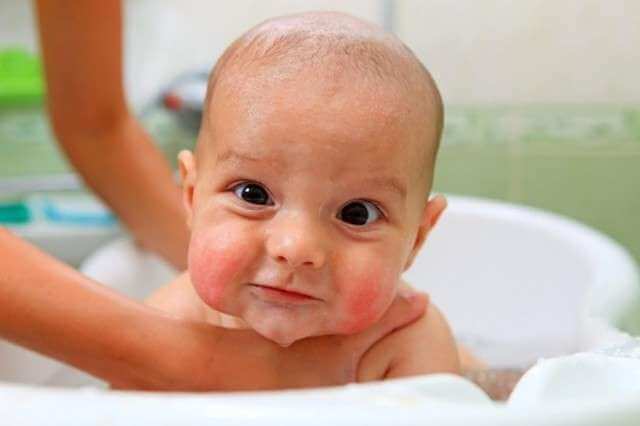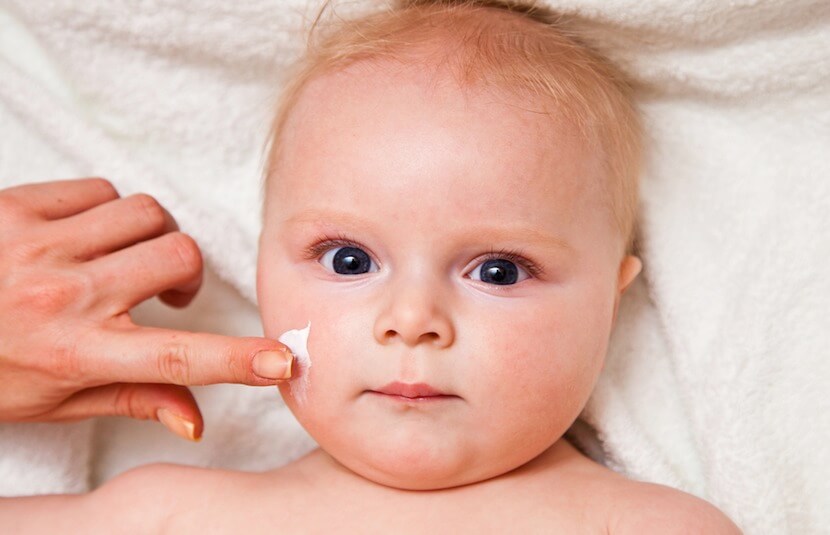How to Treat Atopic Dermatitis In Children

Atopic dermatitis has become one of the most frequent cutaneous diseases in children and babies. Approximately 20% of children under the age of 6 suffer from it and the most common cause has to do with feeding changes. It can also occur because of pollution or a lack of breastfeeding.
Atopic dermatitis is an inflammatory disease of the skin and it has quite uncomfortable symptoms. It appears as itchy reddish lesions which usually apear in rounded areas such as the chin, knees, elbows and forehead. The lesiones are also common on feet, hands, torso and the neck in children.
Some advice on treating atopic dermatitis
A baby’s skin is almost five times thinner than the skin of an adult and because of this we should be very careful. Atopic dermatitis causes an alteration of the immune system of the skin and the lipid mantle that protects it. This creates an epidermal imbalance in children who suffer from the disease.
This is why it’s recommended that you don’t use products that can cause further erosion of skin. Products made from wool, strong detergents and other chemicals. In addition, the following precautions are recommended in order to treat atopic dermatitis.
- Children who suffer from this disease have very sensitive skin. Therefore we must avoid using products that can irritate the skin. We should also avoid clothes that are made of wool or synthetic fibers. Recommended materials include cotton and silk.
- Children’s clothing should be washed with soap rather than detergent. You can use soaps that are made for delicate clothes. After you put the clothes in the washing machine, rinse them well in order to make sure there are no traces of soap left in it. It is also important to not use bleach!
- Children with atopic dermatitis should have a balanced diet. Avoid salty foods, pepper, artificial condiments and spices.
- Prevent the child from undergoing sudden changes in temperature from very hot to very cold environments.
A good bath, the most important part of treatment

Good hygiene along with good skin hydration can help reduce symptoms of atopic dermatitis. Herbal moisturizing creams achieve good results in the treatment of flare-ups.
Specialists sometimes recommend treatment with white mallow, a plant that soothes and alleviates symptoms. It fights irritation and moisturizes the skin at the same time. It also protects from other external stimuli that can damage skin, and contains Vitamin A, B1,B2 and C.
Wild pansy (Viola Tricolor) is a plant that can also be used as a form of treatment. It relieves itching, is a great antiseptic and also softens cracked skin.
Experts also advocate for the use of coconut oil which is a great moisturizer and brings a certain freshness to skin
Baths are very important in order to relieve a bit of the skin discomfort that a child feels. Yet bathing various times a day is not recommended. Once a day is enough to hydrate the skin.
Recommendations for bathing a child suffering from atopic dermatitis

A series of guidelines have been established when it comes to bath time. They are as follows
- Daily bath (15-minutes long)
- The water should be warm, not above 32-34 degrees Celsius
- Use shower gel that doesn’t irritate their skin
- Dry gently without rubbing. Tap with a soft towel that will not cause skin discomfort
- Use hypoallergenic moisturizing products that don’t have perfume. Moisturize their skin immediately after their bath. This will reduce itching and burning sensations
- Only specific areas of affected skin should be treated with medications indicated by your doctor.
- They should wear cotton clothes
- Prevent the child from being too cold or hot
- Their nails should always be kept short and clean in order to prevent infection when they scratch
- Their skin should be constantly hydrated in order to avoid itchiness.
Atopic dermatitis has become one of the most frequent cutaneous diseases in children and babies. Approximately 20% of children under the age of 6 suffer from it and the most common cause has to do with feeding changes. It can also occur because of pollution or a lack of breastfeeding.
Atopic dermatitis is an inflammatory disease of the skin and it has quite uncomfortable symptoms. It appears as itchy reddish lesions which usually apear in rounded areas such as the chin, knees, elbows and forehead. The lesiones are also common on feet, hands, torso and the neck in children.
Some advice on treating atopic dermatitis
A baby’s skin is almost five times thinner than the skin of an adult and because of this we should be very careful. Atopic dermatitis causes an alteration of the immune system of the skin and the lipid mantle that protects it. This creates an epidermal imbalance in children who suffer from the disease.
This is why it’s recommended that you don’t use products that can cause further erosion of skin. Products made from wool, strong detergents and other chemicals. In addition, the following precautions are recommended in order to treat atopic dermatitis.
- Children who suffer from this disease have very sensitive skin. Therefore we must avoid using products that can irritate the skin. We should also avoid clothes that are made of wool or synthetic fibers. Recommended materials include cotton and silk.
- Children’s clothing should be washed with soap rather than detergent. You can use soaps that are made for delicate clothes. After you put the clothes in the washing machine, rinse them well in order to make sure there are no traces of soap left in it. It is also important to not use bleach!
- Children with atopic dermatitis should have a balanced diet. Avoid salty foods, pepper, artificial condiments and spices.
- Prevent the child from undergoing sudden changes in temperature from very hot to very cold environments.
A good bath, the most important part of treatment

Good hygiene along with good skin hydration can help reduce symptoms of atopic dermatitis. Herbal moisturizing creams achieve good results in the treatment of flare-ups.
Specialists sometimes recommend treatment with white mallow, a plant that soothes and alleviates symptoms. It fights irritation and moisturizes the skin at the same time. It also protects from other external stimuli that can damage skin, and contains Vitamin A, B1,B2 and C.
Wild pansy (Viola Tricolor) is a plant that can also be used as a form of treatment. It relieves itching, is a great antiseptic and also softens cracked skin.
Experts also advocate for the use of coconut oil which is a great moisturizer and brings a certain freshness to skin
Baths are very important in order to relieve a bit of the skin discomfort that a child feels. Yet bathing various times a day is not recommended. Once a day is enough to hydrate the skin.
Recommendations for bathing a child suffering from atopic dermatitis

A series of guidelines have been established when it comes to bath time. They are as follows
- Daily bath (15-minutes long)
- The water should be warm, not above 32-34 degrees Celsius
- Use shower gel that doesn’t irritate their skin
- Dry gently without rubbing. Tap with a soft towel that will not cause skin discomfort
- Use hypoallergenic moisturizing products that don’t have perfume. Moisturize their skin immediately after their bath. This will reduce itching and burning sensations
- Only specific areas of affected skin should be treated with medications indicated by your doctor.
- They should wear cotton clothes
- Prevent the child from being too cold or hot
- Their nails should always be kept short and clean in order to prevent infection when they scratch
- Their skin should be constantly hydrated in order to avoid itchiness.
This text is provided for informational purposes only and does not replace consultation with a professional. If in doubt, consult your specialist.








